quote:
Mention is made in Revelation of a "lake of fire" set aside for the ungodly and the Devil (Serpent). My studies of Mesopotamian myths have failed to identify the above motifs in their notions of the underworld. It is a different case, however, with the Egyptian and Greek myths.
Mesopotamian myths make no mention of a "lake of fire" or a body of water that is fiery in the underworld. Greek myths also fail to mention a "lake of fire," but they do mention two "fiery" rivers of the underworld, evidently branches of the river Styx. The first river is called Phlegethon meaning "the flaming" while the second river is called Pyriphlegthon meaning "flaming with fire". [...]
Egyptian myths speak of a "fiery Pool, Sea or Lake" in the underworld and show this body of fiery water on the walls of tombs- Horning calls the body of water "Der Feuersee" or Fire-Sea (cf. tomb wall paintings of the period of Sethos I and Ramses VI, p. 160, figures 130-132 [in color], Erik Horning Tal der Konige, Die Ruhestatte der Pharaonen, Augsburg, Weltbild Verlag GmbH, 1995, ISBN 3-89350-741-8)
Fiery Sea of the Underworld, painted red, in tomb of Pharaoh Seti I (11291-1278 BCE) with souls of the dead, small trees before them.
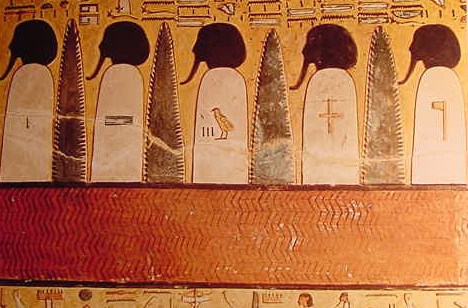
Pool of Fiery Water, painted red, with burning braziers and baboons, from the Book of the Dead.
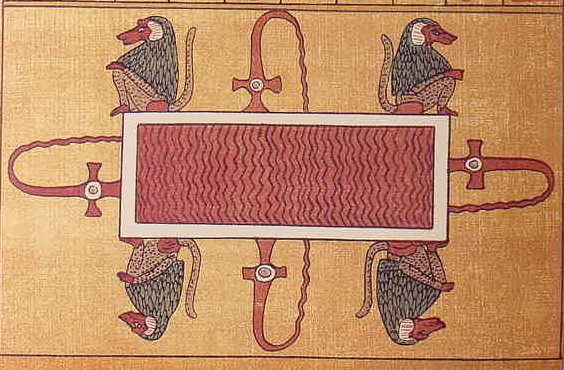
Unrighteous dead, "head-down", in a Fiery Pit of eternal punishment.
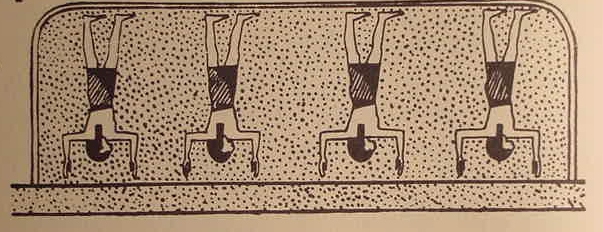
Enemies being burned in a fiery pit, then heads of the damned being burned in another fiery pit.
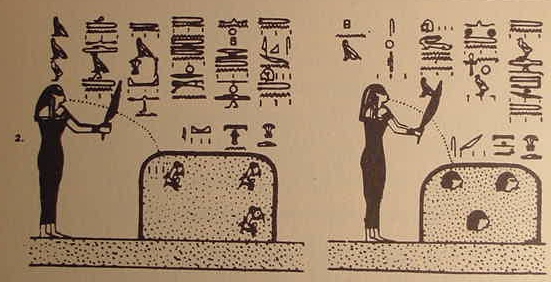
Golet observes on the Papyris of Ani (ca. 1250 BCE), a version of the so-called "Book of the Dead" (with magic charms to ensure the righteous dead make it to the Egyptian paradise) :
"The scene shows four cynocephalous baboons sitting at the corners of a rectangular pool. On each side of this pool is a flaming brazier. The pool's red color indicates that it is filled with a fiery liquid, reminding one of the 'Lake of Fire' frequenty mentioned in the Book of the Dead." (p.168, commentary to plate 32 [in color], Raymond Faulkner and Ogden Goelet, The Egyptian Book of the Dead, The Book of Going Forth by Day, San Francisco, Chronicle Books, 1994, ISBN 0-8118-0767-3)
Muller notes scenes of the damned being tortured in the underworld. They are hacked up with knives, consumed in flames erupting from a great underworld serpent or dragon, dragon in Greek means "great serpent" (fig.187. p.179. W. Max Muller. The Mythology of All Races, Egyptian. Vol. XII. Boston. Marshall Jones Company. 1918) placed in fiery pits, their bodies or "shades" float in underworld an river, the subterranean Nile (fig. 188. p. 180), or consigned to "a lake of fire" after judgement (fig. 186. p.179).
Bernstein's scholarly work on the origins of Hell, notes that the Egyptian damned are placed in firey pits, hacked up, burnt by fiery serpents, or placed in a lake of fire, but, this is NOT an eternal punishment, each day brings a new round of destruction for the newly dead, quite contrary to the Christian notion of the damned enduring Hell fire for all eternity.
Bernstein:
"However horrible the suffering of these victims, their punishment is not eternal. The dismemberment and burning lead to quick destruction. Each night, Re or Osiris consumes the enemies collected the previous day." (Alan E. Bernstein. Death and Retribution in the Ancient and Early Christian Worlds. Ithaca & London. Cornell University Press. 1993)
Perhaps early Christians dwelling in Egypt picked up the Egyptian and Greek themes and transformed the "fiery" rivers and "fiery" lake/sea/pool into a "lake of fire" ?
The motif of judgements of the dead appear in both Mesopotamian, Egyptian, and Greek myths. The big difference is that only the Egyptian myths have the notion of a reward of a blissful life along the fruit tree-laden banks of a heavenly freshwater Nile while the Mesopotamians see only a dismal life for eternity in a dark and dusty underworld for the righteous and unrighteous (cf. p.279, illustration of "The field of reeds" E.A. Wallis Budge,
The Dwellers on the Nile, N.Y. Dover Pub., [1926], 1977).
Greek myths later embrace the notion of Elysian fields for the righteous dead.
The Christian myths mirror the Egyptian paradise to a degree, the saved will, like the righteous Egyptians, wander the banks of a great freshwater river called the water of life, that issues from under God's throne in Jerusalem, empting into the Dead Sea, and will partake of the fruits on its trees lining its banks (Rev 22:2).
Budge (an Egyptologist) points out Christian indebtedness to Egyptian themes of the underworld:
"All the available evidence goes to show that whilst the Hebrew conception of Leviathan was of Babylonian origin that of a hell of fire was borrowed from Egypt. Similarly, the seven-headed dragon and beast of the book of Revelation, like the seven-headed basilisk serpent mentioned in Pistis Sophia, have their origin in the seven-headed serpent which is mentioned in the Pyramid texts." (p.279, Vol.1, E.A. Wallis Budge, The Gods of the Egyptians, NY, Dover Pub. Inc., [1904] 1969).
Not noted by Budge, is the appearance of seven-headed serpents and serpent-dragons in Mesopotamian art forms.
The god Ningirsu is portrayed slaying a seven-headed fiery dragon-serpent called a Mushmahhhu (cf. p. 165, fig. 135, Jeremy Black and Anthony Green, Gods, Demons, and Symbols of Ancient Mesopotamia, An Illustrated Dictionary, University of Austin Press, 1992).
Heidel shows a Sumerian mace head with a seven-headed serpent on it and a cylinder seal with two gods slaying a fiery seven-headed serpent-dragon (cf. figs. 15, 16, Alexander Heidel, The Babylonian Genesis, Universtity of Chicago Press, [1942], 1994)
I note that in Revelation an angel appears with a chain to bind the great serpent (Dragon, Satan, the Devil) in the underworld for a period of time.
Budge noted that in the Egyptian Book of the Dead, that a great serpent, called Apep (Greek: Apophis), which dwelt in the underworld (It was the enemy of Osiris, the god of the resurrection, and it sought to destroy men's souls) is to be fettered in chains, abused, and then his body is to be destroyed finally by fire (cf. Vol.1, pp.324-5, "Ra and Apep," E.A. Wallis Budge, The Gods of the Egyptians, N.Y., Dover Pub., [1904], 1969).
"...the deceased says: 'I have brought fetters to thee, O Ra, and Apep has fallen because thou hast drawn them tight. The gods of the South, and of the North, of the West and of the East have fastened chains upon him, and they have fastened him with fetters; the god Rekes hath overthrown him, and the god Hertit hath put him in chains." (Vol. 1, p.325, Budge)
"He (Apep) is given over to the fire which obtains mastery over him...his bones are burnt with the fire...may his soul, and body, and spirit...nevermore exist." (Vol.1, pp.270-1, Budge, Gods of the Egyptians)
"Apop bound in the Lower World." Louis Herbert Gray. The Mythology of All Races, Egyptian and Indo-Chinese.
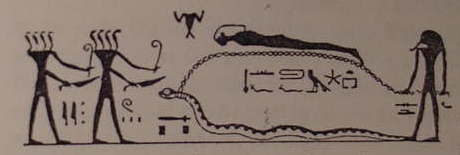
The great serpent Apop (Apep or Apophis), bound by a chain, in the underworld, and about to be carved up by knife wielding followers of Horus the Sun-god, who will then consign his cut-up body to the flames of destruction. In Egyptian myths, the great sea serpent sought to devour the sun and the righteous dead, as it passed through the underworld at night on a solar bark. Perhaps the Christian notion of Satan as a great dragon (in Greek dragon means "great serpent") bound in chains and consigned to the underworld, is drawing to some degree from Egyptian myths ? Alexandria, Egypt had a sizable Hellenized Jewish and Christian community in antiquity which could have assimilated some the Egyptian motifs which appear in the Book of Revelation.






 UBBFriend: Email this page to someone!
UBBFriend: Email this page to someone!
 Printer-friendly view of this topic
Printer-friendly view of this topic